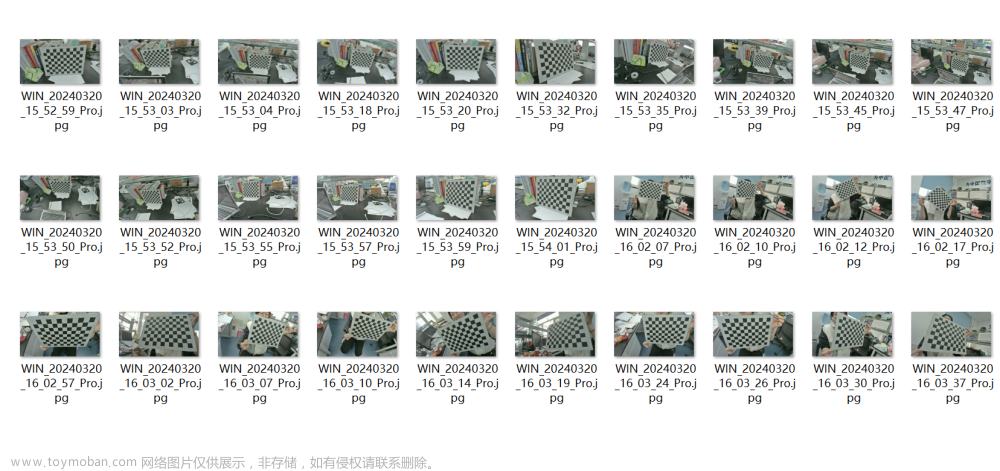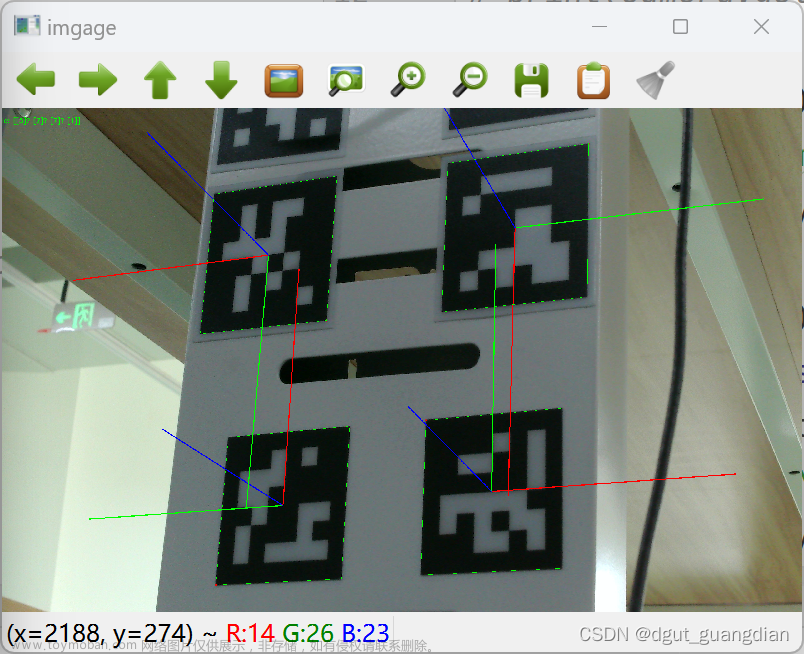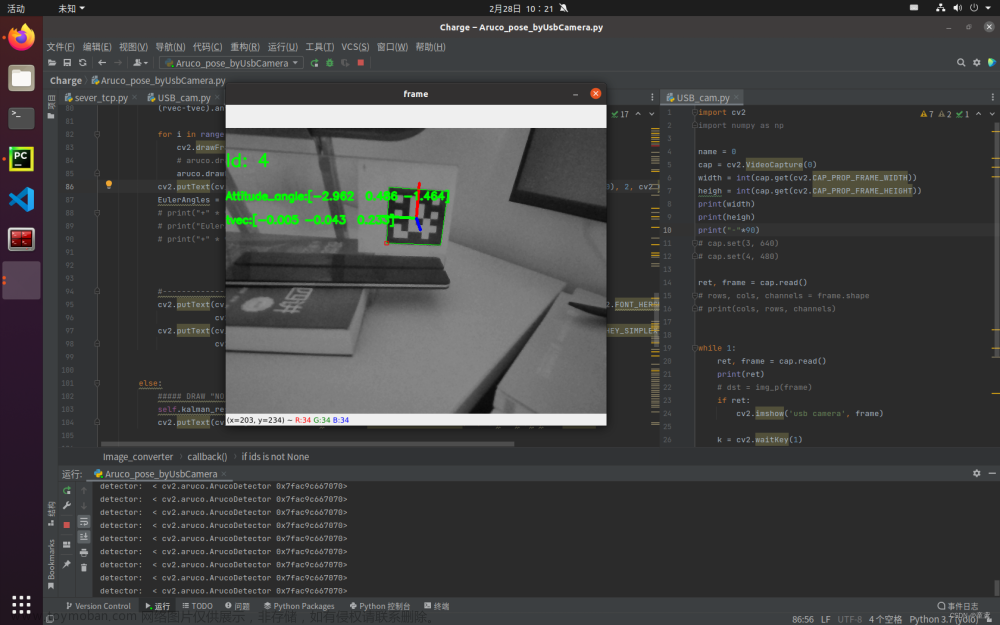环境:python3.7 opencv-contrib-python 4.5.1.48
一、相机标定
相机标定就是求相机的内参矩阵mtx和畸变系数dist
- 首先需要利用相机(你需要标定的)拍摄标定板照片,20张左右。拍摄照片的时候各个角度都拍一些,可以变换标定板的位置,但不要大幅度变换相机(不要翻转镜头,上下颠倒相机等等)。

拍摄的时候看一下照片的属性,这个分辨率需要和后边识别marker时的视频流分辨率保持一致,否侧会测距不准。(博主踩过的大坑这是)
- 我标定的时候把重投影误差大于0.3个像素的删除了,这样标定的比较准一些。
import numpy as np
import cv2
import glob
cap = cv2.VideoCapture(1)
# 设置视频流的分辨率为 1280x720
cap.set(cv2.CAP_PROP_FRAME_WIDTH, 1280)
cap.set(cv2.CAP_PROP_FRAME_HEIGHT, 720)
# 设置用于相机标定的迭代算法的终止条件
criteria = (cv2.TERM_CRITERIA_EPS + cv2.TERM_CRITERIA_MAX_ITER, 30, 0.001)
# 设置棋盘格的规格
chessboard_size = (11, 8) # 棋盘格内角点数目
# 初始化对象点和图像点列表
objpoints = [] # 3D points in real world space
imgpoints = [] # 2D points in image plane.
# 准备棋盘格对象点
objp = np.zeros((chessboard_size[0] * chessboard_size[1], 3), np.float32)
objp[:, :2] = np.mgrid[0:chessboard_size[0], 0:chessboard_size[1]].T.reshape(-1, 2)
# 遍历所有的图像文件路径
images = glob.glob('checkerboard1/*.jpg')
# 遍历所有的图像文件路径
for fname in images:
img = cv2.imread(fname) # 读取当前图像文件
gray = cv2.cvtColor(img, cv2.COLOR_BGR2GRAY) # 将当前图像转换为灰度图
# 查找棋盘格角点
ret, corners = cv2.findChessboardCorners(gray, chessboard_size, None)
# 如果找到棋盘格角点
if ret:
# 将棋盘格角点添加到imgpoints列表中
imgpoints.append(corners)
# 添加相应的3D对象点
objpoints.append(objp)
# 使用对象点和图像点进行相机标定,得到相机的内参矩阵、畸变系数以及旋转矩阵和平移矩阵
ret, mtx, dist, rvecs, tvecs = cv2.calibrateCamera(objpoints, imgpoints, gray.shape[::-1], None, None)
# 剔除重投影误差大于0.3的图像
new_objpoints = []
new_imgpoints = []
for i in range(len(objpoints)):
imgpoints2, _ = cv2.projectPoints(objpoints[i], rvecs[i], tvecs[i], mtx, dist)
error = cv2.norm(imgpoints[i], imgpoints2, cv2.NORM_L2) / len(imgpoints2)
if error <= 0.3:
new_objpoints.append(objpoints[i])
new_imgpoints.append(imgpoints[i])
# 使用剔除后的点重新进行相机标定
ret, mtx, dist, rvecs, tvecs = cv2.calibrateCamera(new_objpoints, new_imgpoints, gray.shape[::-1], None, None)
# 计算重投影误差
mean_error = 0
for i in range(len(new_objpoints)):
imgpoints2, _ = cv2.projectPoints(new_objpoints[i], rvecs[i], tvecs[i], mtx, dist)
error = cv2.norm(new_imgpoints[i], imgpoints2, cv2.NORM_L2) / len(imgpoints2)
mean_error += error
print("\剔除后相机内参:")
print(mtx)
print("\剔除后畸变系数")
print(dist)
# 输出重投影误差
print("\剔除后重投影", mean_error / len(new_objpoints))
3.输出结果
记住内参矩阵和畸变系数
二、计算相机位姿
1.导入库
import numpy as np
import cv2
import cv2.aruco as aruco
import math
2.捕捉视频流
设置视频流的分辨率(跟前边标定相机时拍摄照片的分辨率保持一致)
cap = cv2.VideoCapture(1)
# 设置视频流的分辨率为 1280x720
cap.set(cv2.CAP_PROP_FRAME_WIDTH, 1280)
cap.set(cv2.CAP_PROP_FRAME_HEIGHT, 720)
3.ArUco字典对象(我设置的是5*5)
aruco_dict = aruco.getPredefinedDictionary(aruco.DICT_5X5_100)
4.写计算位姿的函数
def estimate_pose(frame, mtx, dist):
# 将图像转换为灰度图
gray = cv2.cvtColor(frame, cv2.COLOR_BGR2GRAY)
parameters = aruco.DetectorParameters_create()
# 检测图像中的ArUco标记
corners, ids, rejectedImgPoints = aruco.detectMarkers(gray, aruco_dict, parameters=parameters, cameraMatrix=mtx, distCoeff=dist)
font = cv2.FONT_HERSHEY_SIMPLEX
# 如果检测到ArUco标记
if ids is not None and len(ids) > 0:
for i in range(len(ids)): # 遍历每个检测到的ArUco标记
# 估计ArUco标记的姿态(旋转向量和平移向量)
rvec, tvec, _ = aruco.estimatePoseSingleMarkers(corners[i], 0.10, mtx, dist)
R, _ = cv2.Rodrigues(rvec) # 将旋转向量(rvec)转换为旋转矩阵(R)3*3
R_inv = np.transpose(R) # 旋转矩阵是正交矩阵,所以它的逆矩阵等于它的转置 R_inv 表示从相机坐标系到标记坐标系的旋转。
if tvec.shape != (3, 1):
tvec_re = tvec.reshape(3, 1)
#print('-------tvec_re------')
#print(tvec_re)
tvec_inv = -R_inv @ tvec_re
tvec_inv1 = np.transpose(tvec_inv)
pos = tvec_inv1[0]
print(pos)
distance = math.sqrt(pos[0]**2 + pos[1]**2 + pos[2]**2)
rad = pos[0]/pos[2]
angle_in_radians = math.atan(rad)
angle_in_degrees = math.degrees(angle_in_radians)
# 绘制ArUco标记的坐标轴
cv2.drawFrameAxes(frame, mtx, dist, rvec, tvec, 0.05)
tvec_inv_str = " ".join([f"{num:.2f}m" for num in tvec_inv1.flatten()])
cv2.putText(frame, "tvec_inv: " + tvec_inv_str, (0, 80), font, 1, (0, 255, 0), 2, cv2.LINE_AA)
cv2.putText(frame, 'distance:' + str(round(distance, 4)) + str('m'), (0, 110), cv2.FONT_HERSHEY_SIMPLEX, 1,
(0, 255, 0), 2,
cv2.LINE_AA)
cv2.putText(frame, "degree: " + str(angle_in_degrees), (0, 150), font, 1, (0, 0, 255), 2, cv2.LINE_AA)
# 获取ArUco标记相对于相机坐标系的位置
# pos_str_cam = f"X: {tvec_inv1[0][0][0]:.2f}m, Y: {tvec_inv1[0][0][1]:.2f}m, Z: {tvec[0][0][2]:.2f}m"
# 在图像上标注ArUco标记的相对于相机坐标系的位置信息
# cv2.putText(frame, pos_str_cam, (int(corners[i][0][0][0]), int(corners[i][0][0][1]) - 10),
# font, 0.5, (0, 255, 0), 1, cv2.LINE_AA)
# 在图像上绘制检测到的ArUco标记
aruco.drawDetectedMarkers(frame, corners)
# 如果没有检测到ArUco标记,则在图像上显示"No Ids"
else:
cv2.putText(frame, "No Ids", (0, 64), font, 1, (0, 255, 0), 2, cv2.LINE_AA)
return frame # 返回处理后的图像
注意:aruco.estimatePoseSingleMarkers()函数输出的rvec和tvec是marker的中点相对于相机坐标系的旋转向量和平移向量。而我们要求的是相机相对于marker坐标系的位姿。所以需要将rvec和tvec进行一下坐标系变换。如下:文章来源:https://www.toymoban.com/news/detail-861387.html
R, _ = cv2.Rodrigues(rvec) # 将旋转向量(rvec)转换为旋转矩阵(R)3*3
R_inv = np.transpose(R) # 旋转矩阵是正交矩阵,所以它的逆矩阵等于它的转置 R_inv 表示从相机坐标系到标记坐标系的旋转。
if tvec.shape != (3, 1):
tvec_re = tvec.reshape(3, 1)
#print('-------tvec_re------')
#print(tvec_re)
tvec_inv = -R_inv @ tvec_re
tvec_inv1 = np.transpose(tvec_inv)
pos = tvec_inv1[0]
print(pos)
while True:
ret, frame = cap.read()
if not ret:
break
mtx = np.array([
[711.77689507, 0, 672.53236606],
[0, 711.78573804, 313.37884074],
[0, 0, 1],
])
dist = np.array( [1.26638295e-01, -1.16132908e-01, -2.24690373e-05, -2.25867957e-03, -6.76164003e-02] )
# 调用estimate_pose函数对当前帧进行姿态估计和标记检测
frame = estimate_pose(frame, mtx, dist)
new_width = 1280
new_height = 720
frame = cv2.resize(frame, (new_width, new_height))
cv2.imshow('frame', frame)
# 等待按键输入,如果按下键盘上的'q'键则退出循环
if cv2.waitKey(1) & 0xFF == ord('q'):
break
# 释放VideoCapture对象
cap.release()
cv2.destroyAllWindows()
三、效果
 文章来源地址https://www.toymoban.com/news/detail-861387.html
文章来源地址https://www.toymoban.com/news/detail-861387.html
到了这里,关于利用ArUco码实现相机位姿估计(Python)的文章就介绍完了。如果您还想了解更多内容,请在右上角搜索TOY模板网以前的文章或继续浏览下面的相关文章,希望大家以后多多支持TOY模板网!










